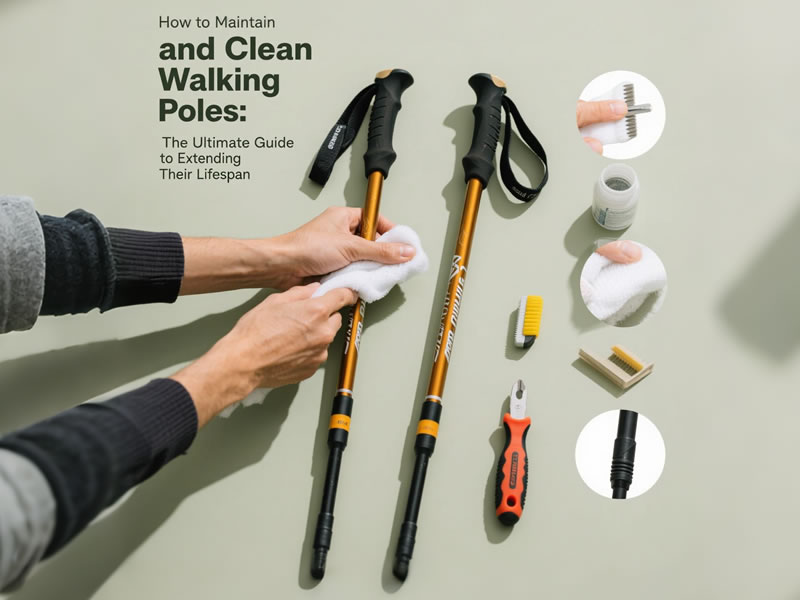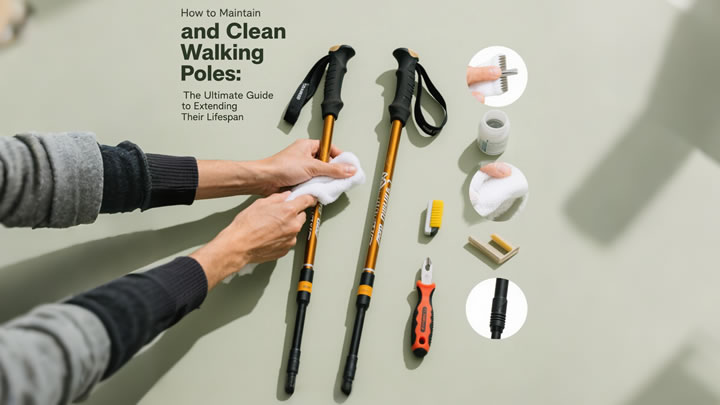How to Maintain and Clean Walking Poles: The Ultimate Guide to Extending Their Lifespan
Your walking poles are trusted companions on the trail, bearing weight, absorbing impact, and providing stability through countless miles. Like any precision equipment, they require regular maintenance to perform reliably and last for years. Proper care prevents premature wear, costly replacements, and—most importantly—equipment failure when you need them most. This comprehensive guide will walk you through the essential steps of cleaning, maintaining, and storing your poles to keep them in peak condition.

Why Regular Maintenance is Non-Negotiable
Neglecting your poles leads to a cascade of problems. Dirt and grit act as abrasives, wearing down locking mechanisms and shaft coatings. Moisture left unchecked causes internal corrosion, leading to stuck sections or weakened integrity. Salt from sweat can degrade foam grips, while neglected tips lose their grip. A few minutes of care after each hike pays massive dividends in performance and safety.
The Post-Hike Cleaning Routine (5-Minute Protocol)
After every hike, dedicate just five minutes to this basic clean-up:
- Wipe Down the Shafts: Use a damp cloth to wipe down the entire length of each pole shaft. This removes mud, dust, and trail grime that can scratch the surface or work its way into the locks. For carbon fiber poles, this is especially crucial to prevent surface damage.
- Inspect and Clean the Tips: Check the carbide or rubber tips for embedded rocks or debris. A small pick or the tip of another pole can dislodge stubborn particles. Wipe them clean to maintain optimal traction.
- Check the Baskets: Remove any leaves, twigs, or mud packed into the baskets.
- Air Dry: Extend the poles fully and leave them in a dry, well-ventilated area away from direct heat sources. Never store poles collapsed or damp.
The Deep Cleaning & Maintenance Session (Monthly or After Muddy Hikes)
When poles are particularly dirty or on a regular monthly schedule, perform a more thorough maintenance:
Step 1: Disassemble and Soak
- Grips and Straps: For removable grips, take them off. Hand-wash grips and straps with a mild soap solution (like dish soap) and a soft brush. Rinse thoroughly and air dry.
- Shafts and Locks: For a deep clean, carefully disassemble the poles according to the manufacturer's instructions. Use a soft brush (an old toothbrush works perfectly) to scrub dirt from the locking mechanisms and the connecting threads.
Step 2: The Locking Mechanism Overhaul
The locks are the heart of your adjustable poles. Grit is their enemy.
- Flick-Locks/Lever-Locks: Use a cotton swab to carefully clean inside the lever mechanism and the locking collar. Apply a very small amount of silicone-based lubricant to the moving parts and the locking cam. Avoid WD-40 or oil-based lubricants as they attract more dirt.
- Twist-Locks: These are more prone to dirt accumulation. Clean the internal expanders with a brush and swab. A tiny drop of lubricant on the threads can help, but avoid getting any on the expander itself.
Step 3: Tip and Basket Maintenance
- Replace Worn Tips: Carbide tips wear down over time. If the metal is smooth or the tungsten-carbide studs are gone, it's time for a replacement. Most tips simply screw off.
- Clean Threads: Before installing new tips, clean the male threads on the pole shaft.
Step 4: Grip Care
- Cork Grips: Clean with a damp cloth. Over time, the natural oils from your hands will condition them.
- Foam Grips: These are prone to tearing. Clean gently and avoid using harsh chemicals that can break down the foam.
Proactive Maintenance and Troubleshooting
- Stuck Sections: If pole sections become stuck, try applying a rubber grip (like a jar opener) for better leverage. As a last resort, gently applying heat from a hairdryer to the outer section can expand the metal enough to free it.
- Sticky Locks: This is often caused by dirt or over-lubrication. Disassemble and clean thoroughly.
- Loose Locks: Over time, locks can wear. Some models have an adjustment screw to tighten the tension. Consult your manufacturer's guide.
Proper Storage for Longevity
- Store poles fully extended or fully collapsed to relieve tension on the internal cords of folding poles.
- Keep them in a cool, dry place, ideally hanging vertically or lying flat without heavy items on top.
- Loosen all locking mechanisms during long-term storage to prevent the seals from taking a "set.'
A Simple Maintenance Checklist
- Wipe down shafts after each use
- Air dry fully before storage
- Monthly deep clean of locks and tips
- Check for wear and damage
- Lubricate locks sparingly with silicone lubricant
- Store in a relaxed state in a dry environment
By integrating these simple maintenance habits, you're not just cleaning gear—you're investing in the reliability of a tool that supports your passion for the outdoors. Well-maintained poles are safe poles, ensuring they’re ready to perform flawlessly on your next adventure.






